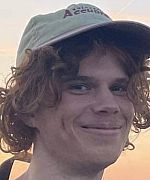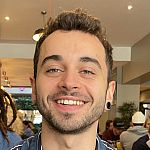Learn more about our Leverhulme Scholars and their research projects.
Cohort 1
Ben White (School of Media, Arts, and Humanities) 
Project title: Predictive theories of mind and human-technology interaction
Supervisors: Prof Andy Clark, Dr Beatrice Fazi
Project description:
I use new theories of cognition and brain function like Active Inference, along with other frameworks from philosophy of cognitive science, to try and better understand how human agents interact with, and are impacted by, technology and their material environments. The project is concerned with questions about mental health and wellbeing, the ethics of design and implementation, and with how best to conceptualize new developments in how technology is used, such as in the case of ambient smart environments or virtual reality. Overall, the aim of the project is to show how approaches utilizing new theoretical frameworks can provide new and useful answers to pressing questions about human-technology interaction.
Amany Azevedo Amin (School of Engineering and Informatics) 
Project title: Multi-Robot Visual Navigation through Insect-Inspired Strategies
Supervisors: Prof Andy Philippides, Prof Paul Graham
Project description:
I am fascinated by how solutions present in biology can inspire and enhance robotics. The main topic of my research is visual navigation. For this, I draw from how animals with small brains (e.g. the desert ant) excel in this field despite limited neural resources. I am currently developing robust insect-inspired navigational strategies for single robots. I am interested in the form of navigational movements, particularly learning routes and search patterns and how these are influenced by bodies and environments. Drawing further inspiration from the animal kingdom, where many members exhibit communication and collaboration, I aim to extend application to navigational tasks which require, or are enhanced by, multiple agents.
Steve Symons (School of Media, Arts and Humanities) 
Project title: Creating entangled instruments: exploring enaction in participatory digital music making environments
Supervisors: Prof Thor Magnusson, Prof Alice Eldridge, Dr Chris Kiefer
Project description:
Collective music making is possibly one of humanity’s oldest socially binding acts. My research explores how technologically mediated social entanglement can create similarly heightened mutual experiences. Imagine someone walking with a dog on a lead. You could perceive this as a hybrid agent emerging from the lead’s entangling of two quite autonomous individuals. I am interested in the affect on participants when such entanglements are used to create human-human, or human-technology, musical experiences where authorship is intrinsically co-dependent. Ultimately the project seeks to explore what creative role and subsequent designs technological agents might have within such intimately collaborative environments.
Anindya Ghosh (School of Engineering and Informatics) 
Project title: Building bio-mimetic algorithms by injecting function into brain models
Supervisors: Dr James Knight, Prof Thomas Nowotny
Project description:
Drawing inspiration from biology, my work pertains to building neuromorphic models that can then be used to enhance robotics. My current muses are insects that can perform seemingly elaborate processes with limited compute. As such, I am using computational neuroscience methods to build robust insect-inspired (e.g., locusts and hoverflies) robotic solutions in the areas of obstacle avoidance and target tracking. I aim to extend my research by investigating mammalian hippocampal processes to create bio-mimetic algorithms that can augment navigational strategies used in robotics.
Eira Watts Moore (School of Life Sciences) 
Project title: Individual differences in spectral processing: nature or nurture
Supervisors: Prof Tom Baden and Prof Jenny Bosten
Project description:
We know that how humans perceive colour can differ from person to person, but we don’t yet know how, why or if the same is true for other species. Unpublished work from the Baden lab suggests that there is a considerable degree of individual variation in the representation of colour in the zebrafish brain. But is this variation the result of true differences between individuals (interindividual variation) or the result of variation within each individual over time (intraindividual variation)? The aims of this project are to understand what leads to these observed differences in the representation of colour in zebrafish, if there are genetic and environmental influences, and to determine where in the visual system these differences are processed.
Cohort 2
Dexter Shepherd (School of Engineering and Informatics) 
Project title: Exploiting chaotic dynamics and bio-inspired feedback for resilient motor control of physical robots
Supervisors: Prof Phil Husbands, Prof Andy Philippides and Dr Chris Johnson
Project description:
Tactile sensing is fundamental in nature, enabling insects and other animals, including humans, to perceive and adapt to their surroundings. When we walk, we continuously adjust our movements based on tactile feedback from the environment. My research sits at the intersection of bio-mimetic engineering and machine learning, focusing on developing tactile sensors that allow robots to sense and adapt their gait to different terrains. A key question driving my work is: what type of tactile sensor should we use? Despite the wide range of available designs, there are currently no fair, systematic comparisons between tactile sensors. This project aims to address this gap by investigating and justifying which sensor technologies are best suited for adaptive robotic locomotion.
Cohort 3
Balázs Mészáros (School of Engineering and Informatics) 
Project title: Structure, Space, Time, and Function in Spiking Neural Networks
Supervisors: Prof Thomas Nowotny and Dr James Knight
Project description:
Historically, computer science and neuroscience have been closely intertwined. However, nowadays most researchers in artificial intelligence show little interest in how biological systems solve problems. My research focuses on incorporating bio-inspired mechanisms into artificial neural networks to improve energy efficiency, enhance temporal processing capacity, and better understand how structure gives rise to function.
Dominic West (School of Psychology) 
Project title: The Role of Attention in Auditory Predictive Processing
Supervisors: Dr Ediz Sohoglu, Dr Jeff Mitchell and Dr Sophie Forster
Project description:
For humans, speech processing is innate and effortless. However, understanding speech requires transforming complex - often ambiguous or unclear - sounds, into coherent meaning. I am interested in how the brain achieves this task. In particular, does the brain perform this transformation automatically (overhearing your name at a party) or does it require attention (not hearing your name if engrossed in a book)? I use EEG to measure the brain’s response to speech when people are paying attention or distracted. I then use various computational tools to map these responses to features in the speech, to reveal the extent to which the brain is tracking speech features when attention is directed elsewhere. In this way, I aim to better understand how, and in what contexts, speech is processed when we hear without listening
Christopher Russell Dunne (School of Engineering and Informatics) 
Project title: Heterogeneous Parallel Processing Enables Adaptive Behaviour in Nonstationary Environments
Supervisors: Dr Dhruva Raman and Prof Chris Buckley
Project description:
Biological organisms exist (and thrive) in complex environments that can both recur and fundamentally change over time. In such nonstationary worlds, adaptive behaviour requires managing a trade-off between using old data to predict the future and discarding it when it is not relevant. In general, artificial agents are not built to manage this trade-off, and suffer from catastrophic interference or need to be retrained when faced with out of distribution data. I am investigating the design principles that underlie this discrepancy, focusing on how heterogeneous parallel models enable more adaptive and robust behaviour across environments at the expense of asymptotic optimality in a single environment. Initial results can be seen here.


